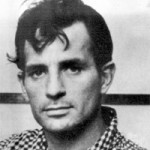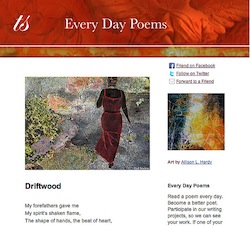My first introduction to the Beat poets was a caricature. As a child, long before I had heard of Jack Kerouac, Allen Ginsburg, Denise Levertov, William Burroughs, Frank O’Hara and Neil Cassaday, I watched a weekly sitcom called The Many Loves of Dobie Gillis, set on a small-town college campus. Dobie (Dwayne Hickman) was the hero, chased by the dowdy Zelda and not by the girls he wanted to be chased by. His best friend was Maynard G. Krebs, played by Bob Denver, who went on to greater fame as the lead character in Gilligan’s Island.
Maynard G. Krebs had a goatee in an era when all men shaved. He wore a beret. He acted kind of goofy. He used slang that accentuated the goofiness. Maynard was a beatnik, but a lovable beatnik. We loved to laugh at Maynard G. Krebs. Denver played the character with innocence and often naiveté; Maynard was the child in all of us.
The caricature, safely homogenized for television audiences, including berets, smoke-filled coffeehouses, and poetry. Coffeehouse denizens listening to Beat poets didn’t applaud; they nodded and snapped their fingers.
The work “beatnik” didn’t enter the American vocabulary until 1958, six years after the “Beat Generation” made its appearance. According to Louis Menand, writing in The New Yorker in 2007, San Francisco columnist Herb Caen morphed the word “beat” into beatnik. (Later, in the 1960s, hippies were sometimes referred to as beatniks who didn’t bathe.)
The reality of “beatniks” and “Beat” is more complex.
It was writer and novelist John Clellon Holmes, writing in The New York Times Magazine in November 1952, who popularized the term “Beat.” He was referring to the post-World War II generation in much the same way that “Lost Generation” referred to the post-World War I world. And the word “beat” wasn’t a reference to music or rhythm. Menand pointed out in The New Yorker that “the term has nothing to do with music; it names the condition of being beaten down, poor, exhausted, at the bottom of the world.”
Holmes maintained that he first heard the word “Beat” as a generational reference from Jack Kerouac. He used it in the article and in his 1952 novel Go, published six years before one of the most famous of Beat literary efforts, Kerouac’s On the Road. (The only work as famous as Kerouac’s novel was Allen Ginsberg’s long poem, Howl, and it was famous for its role in a major national obscenity trial.)
While the name “Beat” suggests a common view, a common perspective and a shared understanding, the Beat writers were actually quite diverse. Some, like Frank O’Hara, remained closer to the conventional literary world. Others, including Kerouac, moved closer to the unconventional. William Burroughs was in a class by himself, and likely redefined the word “unconventional.”
They wrote about each other. They show up as characters in Beat novels, and Beat poets often wrote to and about each other. (Beat poets were often known for their loud poetry readings, and they insisted that their poems had to be read aloud to truly be understood.) Part of the aura of being a Beat writer was to live fast and hard, and many of them did exactly that.
This poem by a lesser known Beat poet, Bob Kaufman, captures both the self-referencing of the Beats and the essential “oral” nature of much of Beat poetry (it’s included in the Everyman’s Library / Pocket Poets edition Beat Poets, published in 2002):
West Coast Sounds (1956)
San Fran, hipster land,
Jazz sounds, wig sounds,
Earthquake sounds, others,
Allen on Chestnut Street,
Giving poetry to squares,
Corso on knees, pleading,
God eyes.
Rexroth, Ferlinghetti,
Swinging, in cellars,
Kerouac at Locke’s,
Writing Neil
On high typewriter,
Neil, booting a choo-choo,
On zigzag tracks.
Now, many cats
Falling in,
New York cats,
Too many cats,
Monterey scene cooler,
San Franers, falling down.
Canneries closing.
Sardines splitting
For Mexico.
Me too.
Really cool, man, really cool. (Sound of snapping fingers after reading.)
The Beats were unconventional, and they would have a major impact on American (and even European) culture in the 1960s. Timothy Leary would hook up with the Beats; most of the 1960s did, too.
For the remaining Tuesdays in the month of September, we’ll be featuring an article on a Beat poet: Jack Kerouac on Sept. 9, Allen Ginsberg on Sept. 16, Denise Levertov on Sept. 23, and Frank O’Hara on Sept. 30.
To read more on the Beat Generation:
The Portable Beat Reader by Ann Charters (2003)
The Naked Angels: The Lives and Literature of the Beat Generation by John Lytell (2006)
Women of the Beat Generation: The Writers, Artists and Muses at the Heart of a Revolution by Brenda Knight (1998)
The Beat Book: Writings from the Beat Generation by Anne Waldman and Allen Ginsberg (2007)
The Beats: From Kerouac to Kesey, An Illustrated Journey Through the Beat Generation by Mike Evans (2007)
The best known works by Beat writers include Kerouac’s On the Road, Ginsberg’s Howl, Burroughs’ Naked Lunch, and Frank O’Hara’s Lunch Poems.
Featured photo by 8mm & Other Stuff, Creative Commons, via Flickr. Post by Glynn Young, author of the novels Dancing Priest and A Light Shining, and Poetry at Work.
Want to brighten your morning coffee?
Subscribe to Every Day Poems and find some beauty in your inbox.
- Poets and Poems: Donna Vorreyer and “Unrivered” - October 7, 2025
- Poet Sidney Lanier and the Lost Cause - October 2, 2025
- Poets and Poems: A.J. Thibault and “We Lack a Word” - September 30, 2025



Maureen Doallas says
Joseph Ceravolo, awarded the first Frank O’Hara prize, also is associated with the group, though he led a quiet life. Wesleyan’s ‘Joseph Ceravolo: Collected Poems’ is something of a sleeper; well worth picking up. I recently read Brad Gooch’s ‘City Poet: The Life and Times of Frank O’Hara”; is well exposes the goings-on of that generation of poets.
Looking forward to your other posts on the Beats, Glynn!
Marcy says
I love it! Bring me back my bell bottom pants, those hip huggers and my lace-up black leather boots. Had bleached blond hair like Twiggy and everything was hip. Wow, the article was great, rattled my memory to some great times in basements where poetry was recited while sitting on big pillows. Looking forward to more.
Will Willingham says
I visited the Beat Museum in San Francisco on Sunday. Unfortunately, my camera battery died, so I’ll need to go back, and I’ll post some photos here of some of the memorabilia in the exhibit.